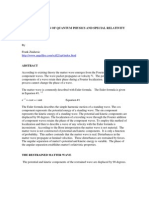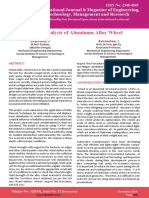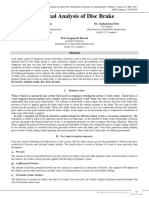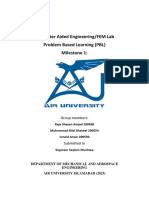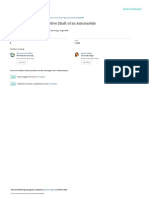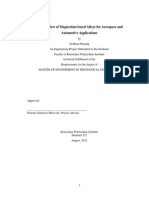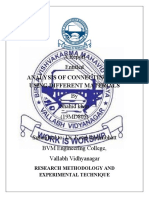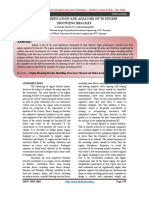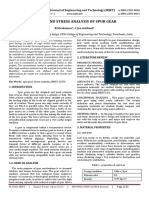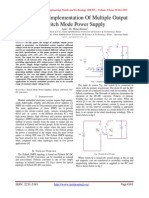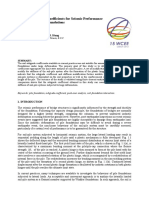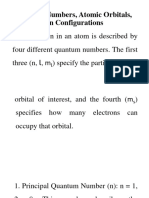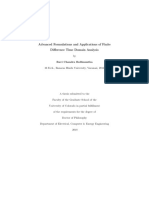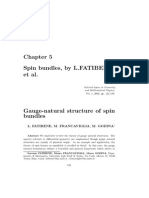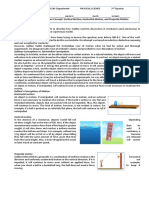0 ratings0% found this document useful (0 votes)
200 viewsStructural Analysis of Disc Brake Rotor
Structural Analysis of Disc Brake Rotor
Uploaded by
seventhsensegroupThis paper deals with the analysis of Disc Brake. A Brake is a device by means of which artificial frictional resistance is applied to moving machine member, in order to stop the motion of a machine. Disc brake is usually made of Cast iron, so it is being selected for Investigating the effect of strength variations on the predicted stress distributions. Aluminium MetalMatrix Composite materials are selected and analysed.The results are compared with existing disc rotor. The model of Disc brake is developed by using Solid modeling software Pro/E (Creo-Parametric 1.0).Further Static Analysis is done by using ANSYS Workbench. Structural Analysis is done to determine the Deflection, Normal Stress ,Vonmises stress.
Copyright:
© All Rights Reserved
Available Formats
Download as PDF, TXT or read online from Scribd
Structural Analysis of Disc Brake Rotor
Structural Analysis of Disc Brake Rotor
Uploaded by
seventhsensegroup0 ratings0% found this document useful (0 votes)
200 views4 pagesThis paper deals with the analysis of Disc Brake. A Brake is a device by means of which artificial frictional resistance is applied to moving machine member, in order to stop the motion of a machine. Disc brake is usually made of Cast iron, so it is being selected for Investigating the effect of strength variations on the predicted stress distributions. Aluminium MetalMatrix Composite materials are selected and analysed.The results are compared with existing disc rotor. The model of Disc brake is developed by using Solid modeling software Pro/E (Creo-Parametric 1.0).Further Static Analysis is done by using ANSYS Workbench. Structural Analysis is done to determine the Deflection, Normal Stress ,Vonmises stress.
Copyright
© © All Rights Reserved
Available Formats
PDF, TXT or read online from Scribd
Share this document
Did you find this document useful?
Is this content inappropriate?
This paper deals with the analysis of Disc Brake. A Brake is a device by means of which artificial frictional resistance is applied to moving machine member, in order to stop the motion of a machine. Disc brake is usually made of Cast iron, so it is being selected for Investigating the effect of strength variations on the predicted stress distributions. Aluminium MetalMatrix Composite materials are selected and analysed.The results are compared with existing disc rotor. The model of Disc brake is developed by using Solid modeling software Pro/E (Creo-Parametric 1.0).Further Static Analysis is done by using ANSYS Workbench. Structural Analysis is done to determine the Deflection, Normal Stress ,Vonmises stress.
Copyright:
© All Rights Reserved
Available Formats
Download as PDF, TXT or read online from Scribd
Download as pdf or txt
0 ratings0% found this document useful (0 votes)
200 views4 pagesStructural Analysis of Disc Brake Rotor
Structural Analysis of Disc Brake Rotor
Uploaded by
seventhsensegroupThis paper deals with the analysis of Disc Brake. A Brake is a device by means of which artificial frictional resistance is applied to moving machine member, in order to stop the motion of a machine. Disc brake is usually made of Cast iron, so it is being selected for Investigating the effect of strength variations on the predicted stress distributions. Aluminium MetalMatrix Composite materials are selected and analysed.The results are compared with existing disc rotor. The model of Disc brake is developed by using Solid modeling software Pro/E (Creo-Parametric 1.0).Further Static Analysis is done by using ANSYS Workbench. Structural Analysis is done to determine the Deflection, Normal Stress ,Vonmises stress.
Copyright:
© All Rights Reserved
Available Formats
Download as PDF, TXT or read online from Scribd
Download as pdf or txt
You are on page 1of 4
International Journal of Computer Trends and Technology (IJCTT) volume 4 Issue 7July 2013
ISSN: 2231-2803 http://www.ijcttjournal.org Page 2295
Structural Analysis of Disc Brake Rotor
K.Sowjanya
#1
, S.Suresh
*2
1
M. Tech-(CAD-CAM), Siddharth Institute of Engineering and Technology, Puttur
2
Associate Professor, Siddharth Institute of Engineering and Technology, Puttur
Abstract ---This paper deals with the analysis of Disc Brake. A
Brake is a device by means of which artificial frictional
resistance is applied to moving machine member, in order to
stop the motion of a machine. Disc brake is usually made of
Cast iron, so it is being selected for Investigating the effect of
strength variations on the predicted stress distributions.
Aluminium MetalMatrix Composite materials are selected and
analysed.The results are compared with existing disc rotor. The
model of Disc brake is developed by using Solid modeling
software Pro/E (Creo-Parametric 1.0).Further Static Analysis is
done by using ANSYS Workbench. Structural Analysis is done
to determine the Deflection, Normal Stress ,Vonmises stress.
Key Words: Disc brake, Pro/E(Creo Parametric1.0), ANSYS
Workbench, Finite Element Analysis.
I. INTRODUCTION
Disc brake consists of a cast iron disc bolted to
the wheel hub and a stationary housing called caliper.
The caliper is connected to some stationary part of the
vehicle like the axle casing or the stub axle as is cast in
two parts each part containing a piston. In between each
piston and the disc there is a friction pad held in position
by retaining pins, spring plates. The passages are so con-
nected to another one for bleeding. Each cylinder
contains rubber-sealing ring between the cylinder and
piston. A schematic diagramis shown in the figure. Due
to the application of brakes on the car disc brake rotor,
heat generation takes place due to friction and this
temperature so generated has to be conducted and
dispersed across the disc rotor cross section. An
investigation into usage of new materials is required
which improve braking efficiency and provide greater
stability to vehicle.
II. DISC BRAKE ROTOR
The Disc brake discs are commonly
manufactured out of grey cast iron. The SAE maintains a
specification for the manufacture of grey iron for various
applications. For normal car and light truck applications,
the SAE specifica-tion is J 431 G3000 (superseded to
G10). This specification dictates the correct range of
hardness, chemical composi-tion, tensile strength, and
other properties necessary for the intended use. Some
racing cars and airplanes use brakes with carbon fiber
discs and carbon fiber pads to reduce weight. Wear rates
tend to be high, and braking may be poor or grabby until
the brake is hot. The mate-rials used for rotor disc are
explained in detail. It is inves-tigated the temperature
distribution, the thermal defor-mation, and the thermal
stress of automotive brake disks have quite close
relations with car safety; therefore, much research in this
field has been performed.
A) Cast Iron:
Cast iron usually refers to grey cast iron, but
identifies a large group of ferrous alloys, which solidify
with a eutectic. Iron accounts for more than 95%, while
the main alloying elements are carbon and silicon. The
amount of carbon in cast iron is the range 2.1-4%, as
ferrous alloys with less are denoted carbon steel by
definition. Cast irons contain appreciable amounts of
silicon, normally 1-3%, and consequently these alloys
should be considered ternary Fe-C-Si alloys. Here
graphite is present in the formof flakes. Disc brake discs
are com-monly manufactured out of a material called
grey cast iron.
B) Aluminum Metal Matrix Composites:
Aluminum is the most popular matrix for the
metal matrix composites (MMCs). The Al alloys are
quite attractive due to their low density, their capability
to be strengthened by precipitation, their good corrosion
resis-tance, high thermal and electrical conductivity, and
their high damping capacity. Aluminum matrix
composites (AMCs) refer to the class of light weight
high perfor-mance aluminum centric material systems.
The rein-forcement in AMCs could be in the formof
continuous or discontinuous fibers, whisker or
particulates, in volume fractions ranging from a few
percent to 70%. In the last few years, AMCs have been
utilized in high-tech struc-tural and functional
applications including aerospace, defense, automotive,
and thermal management areas, as well as in sports and
recreation.
International Journal of Computer Trends and Technology (IJCTT) volume 4 Issue 7July 2013
ISSN: 2231-2803 http://www.ijcttjournal.org Page 2296
There has been interest in using aluminum
based metal matrix composites for brake disc and drum
mate-rials in recent years. While much lighter than cast
iron they are not as resistant to high temperatures and are
sometimes only used on rear axles of automobiles be-
cause the energy dissipation requirements are not high as
compared to front axle. While the friction and wear of al-
mmc were high speeds and loads the behavior could be
greatly improved beyond that of iron discs, given the cor-
rect match of pad and disc material.
III. MODELING OF DISC BRAKE
It is very difficult to exactly model the brake
disk, in which there are still There always a need of
some assumptions to model any complex geometry.
These assumptions are made, keeping in mind the
difficulties involved in the theoretical calculation and
the importance of the parameters that are taken and
those which are ignored. In modeling we always ignore
the things that are of less importance and have little
impact on the analysis. The assumptions are always
made depending upon the details and accuracy required
in modeling. The assumptions which are made while
modeling the process are given below:
1. The disk material is considered as homogeneous and
isotropic.
2. The domain is considered as axis-symmetric.
3. Inertia and body force effects are negligible during the
analysis.
4. The disk is stress free before the application of brake
5. Brakes are applied on the entire four wheels.
6.The analysis does not determine the life of the disk
brake.
7. The disk brake model used is of solid type
And it is not ventilated type.
A)Material names:
AlMMC1;AluminiumMetal Matrix Composite1
AlMMC2; AluminiumMetal Matrix Composite2
CI:CastIron
Fig:1 Model of disc brake
TABLE:1
PROPERTIES OF MATERIALS USED
IV.FINITE ELEMENT ANALYSIS
The finite element method is numerical analysis
technique for obtaining approximate solutions to a wide
variety of engineering problems. Because of its diversity
and flexibility as an analysis tool, it is receiving much
attention in almost every industry. In more and more
engineering situations today, we find that it is necessary
to obtain approximate solutions to problem rather than
exact closed formsolution. It is not possible to obtain
analytical mathematical solutions for many
PROPERTI
ES
GREY CAST
IRON
Al MMC1 Al MM2
DENSITY,
7100 Kg/m3 2765.2 Kg/m3 2820.6 Kg/m3
YOUNGS
MODULU
S,E
125 GPa 98.5 GPa 113.76 GPa
THERMAL
CONDUCT
IVITY, k
54 W/m.K 181.65 W/m.K 147.95 W/m.K
SPECIFIC
HEAT. Cp
586 J /Kg.K 836.8 J /Kg.K 828.43 J /Kg.K
POSSION
S RATIO,
0.25 0.33 0.35
COEFFICI
ENT OF
EXPANSI
ON,
8.1*10-6/0K 17.5*10-6/0K 16.9*10-6/0K
International Journal of Computer Trends and Technology (IJCTT) volume 4 Issue 7July 2013
ISSN: 2231-2803 http://www.ijcttjournal.org Page 2297
engineering problems. An analytical solutions is a
mathematical expression that gives the values of the
desired unknown quantity at any location in the body, as
consequence it is valid for infinite number of location in
the body. For problems involving complex material
properties and boundary conditions, the engineer resorts
to numerical methods that provide approximate, but
acceptable solutions. The finite element method has
become a powerful tool for the numerical solutions of a
wide range of engineering problems. It has been
developed simultaneously with the increasing use of the
high- speed electronic digital computers and with the
growing emphasis on numerical methods for engineering
analysis. This method started as a generalization of the
structural idea to some problems of elastic continuum
problem, started in terms of different equations.
i) STRUCTURAL ANALYSIS
Structural analysis is the most common
application of the finite element analysis. The term
structural implies civil engineering structure such as
bridge and building, but also naval, aeronautical and
mechanical structure such as ship hulls, aircraft bodies
and machine housing as well as mechanical
components such as piston, machine parts and tools.
ii)TYPES OF STRUCTURAL ANALYSIS:
The seven types of structural analyses in ANSYS. One
can performthe following types of structural analysis.
Each of these analysis types are discussed as follows:
Static analysis
Modal analysis
Harmonic analysis
Transient dynamic analysis
Spectrumanalysis
Buckling analysis
Explicit dynamic analysis
Structural static analysis
A static analysis calculates the effects of steady loading
conditions on a structure, while ignoring inertia and
damping effects such as those caused by time varying
loads. A static analysis can, however include steady
inertia loads (such as gravity and rotational velocity),
and time varying loads that can be approximated as
static equivalent loads (such as static equivalent wind
and seismic loads).
V.RESULTS
Fig:2 Meshed model of Disc Brake
Fig:3 Fixed support
A)Cast Iron
Fig:4 Results obtained fromANSYS Work bench
International Journal of Computer Trends and Technology (IJCTT) volume 4 Issue 7July 2013
ISSN: 2231-2803 http://www.ijcttjournal.org Page 2298
B) Al MMC1:
Fig:5 Results obtained for Al MMC1
C)Al MMC2:
Fig:6 Results obtained for Al MMC2
TABLE:2
COMPARISION OF RESULTS
Material Deformation Normal
stress
Vonmises
stress
CI 0.35193 5.8095 50.334
AlMMC1 0.35229 64.812 211.98
AlMMC2 0.36648 65.345 566.7
VI. CONCLUSIONS
The following conclusions are drawn from the present
work.
1. Static structural analysis is carried out by coupling
the Thermal solution to the structural analysis and
the maximum Von Mises stress was observed to be
50.334 M Pa for CI, 211.98 M Pa for AlMMC1, and
566.7 M Pa for AlMMC2.
2. The Brake disc design is safe based on the Strength
and Rigidity Criteria.
3. Comparing the different results obtained from the
analysis, it is concluded that Cast Iron is the best
possible combination for the present application.
REFRENCES
[1] KENNEDY, F. E., COLIN, F. FLOQUET, A. AND
GLOVSKY, R. ImprovedTechniques for Finite Element
Analysis of Sliding Surface Temperatures.Westbury
House page 138-150, (1984).
[2] LIN , J. -Y. AND CHEN, H. -T. Radial Axis
symmetric Transient Heat Conduction in Composite
Hollow Cylinders with Variable Thermal
Conductivity,vol. 10, page 2- 33, (1992).
[3] BRILLA, J . Laplace Transform and New
Mathematical Theory of Visco elasticity,vol. 32, page
187- 195, (1997).
[4] WANG, H. -C. AND BANERJ EE, P. K..
Generalized Axis symmetric
Elastodynamic Analysis by Boundary Element Method,
vol. 30, page 115-131,
(1990).
[5] ZIENKIEWICZ, O. C. The Finite Element method,
McGraw-Hill, New York,
(1977).
[6] BEEKER, A.A. The Boundary Element Method in
Engineering, McGraw-Hill,
New York, (1992).
[7]FLOQUET, A. AND DUBOURG, M.-C. Non axis
symmetric effects for threedimensional Analyses of a
Brake, ASME J . Tribology, vol. 116, page 401-407,
(1994).
You might also like
- Reinforced Concrete Buildings: Behavior and DesignFrom EverandReinforced Concrete Buildings: Behavior and DesignRating: 5 out of 5 stars5/5 (1)
- A Reconciliation of Quantum Mechanics and Special RelativityDocument5 pagesA Reconciliation of Quantum Mechanics and Special RelativityNullpunktsenergieNo ratings yet
- Ijctt V4i7p159 PDFDocument4 pagesIjctt V4i7p159 PDFMadhan RajNo ratings yet
- Fatigue Analysis of Alloy Wheel For Passenger Car Under Radial LoadDocument10 pagesFatigue Analysis of Alloy Wheel For Passenger Car Under Radial Loadsuraj dhulannavarNo ratings yet
- Impact Analysis of Aluminum Alloy Wheel - (V. Sivakrishna, J. Balabashker) PDFDocument11 pagesImpact Analysis of Aluminum Alloy Wheel - (V. Sivakrishna, J. Balabashker) PDFpezz07No ratings yet
- 2 StudyDocument6 pages2 StudyRomiel CaballeroNo ratings yet
- New Project 2Document5 pagesNew Project 2Aashik AhamedNo ratings yet
- Abu Talib CDSDocument8 pagesAbu Talib CDSMatthew SmithNo ratings yet
- Batch 7Document19 pagesBatch 7Maran PrabakaranNo ratings yet
- Thermal Analysis of Disc BrakeDocument6 pagesThermal Analysis of Disc BrakeHygeia Knoll Cloa BorjaNo ratings yet
- Structural Design of An Outer Tie RodDocument7 pagesStructural Design of An Outer Tie Rodyildirim.xasNo ratings yet
- Milestone No. 01 - CAE LABDocument9 pagesMilestone No. 01 - CAE LABMuhammad Junaid Rajput FatimaNo ratings yet
- 225Document7 pages225Stefan AdrianNo ratings yet
- Fatigue Analysis PDFDocument6 pagesFatigue Analysis PDFPallavit NigamNo ratings yet
- Ijett V38P253 PDFDocument7 pagesIjett V38P253 PDFKaustubh DwivediNo ratings yet
- Design and Performance Analysis of Alloy Wheels Using CATIA ANSYS Modeling ToolDocument5 pagesDesign and Performance Analysis of Alloy Wheels Using CATIA ANSYS Modeling ToolAdityaNo ratings yet
- Design and Analysis of Motor Cycle Block Engine Using Different MaterialsDocument10 pagesDesign and Analysis of Motor Cycle Block Engine Using Different Materialsbharathkumar0310No ratings yet
- Magnetic BrakeDocument10 pagesMagnetic BrakeIgnacio Rifo NochezNo ratings yet
- Irjet V8i153Document3 pagesIrjet V8i153FAB squadNo ratings yet
- Ijett V38P253Document7 pagesIjett V38P253Burak KoyuncuogluNo ratings yet
- Design and Analysis of Connecting Rod For Different Material Using AnsysDocument18 pagesDesign and Analysis of Connecting Rod For Different Material Using AnsysGagan GaganNo ratings yet
- An Overview of Magnesium Based Alloys For Aerospace and Automotive ApplicationsDocument36 pagesAn Overview of Magnesium Based Alloys For Aerospace and Automotive Applicationsisus nazarecaninNo ratings yet
- A Comparative Thermal and Structural Analysis of Different Disc Brake MaterialsDocument6 pagesA Comparative Thermal and Structural Analysis of Different Disc Brake MaterialsTJPRC PublicationsNo ratings yet
- Design and Analysis of Go Kart Chassis Ijariie4300 PDFDocument7 pagesDesign and Analysis of Go Kart Chassis Ijariie4300 PDFDeepak RameshNo ratings yet
- Topological Optimization of Automobile Rotor Disk Brake: Vipul Matariya, Hiren PatelDocument5 pagesTopological Optimization of Automobile Rotor Disk Brake: Vipul Matariya, Hiren PatelEmir EsimNo ratings yet
- Static and Thermal Analysis of Piston With Different Thermal CoatingsDocument13 pagesStatic and Thermal Analysis of Piston With Different Thermal CoatingsPinsteritNo ratings yet
- 1 s2.0 S2214785316303856 Main - 3Document7 pages1 s2.0 S2214785316303856 Main - 3mesfin DemiseNo ratings yet
- A Report Entitled: Analysis of Connecting Rod Using Different MaterialsDocument27 pagesA Report Entitled: Analysis of Connecting Rod Using Different MaterialsPathan ShahidkhanNo ratings yet
- Design and Analysis of Connecting Rod For Different Material Using AnsysDocument7 pagesDesign and Analysis of Connecting Rod For Different Material Using AnsysGagan GaganNo ratings yet
- Design and Analysis of Flywheel For Different Geometries and MaterialsDocument6 pagesDesign and Analysis of Flywheel For Different Geometries and Materialsjaison jacobNo ratings yet
- Green Publication,+Journal+Manager,+MCE 5 2017 1Document13 pagesGreen Publication,+Journal+Manager,+MCE 5 2017 1Raghav Singh JaswalNo ratings yet
- Analyzing The Car Disc Brake Using A Combination of Modelling and Static Structural TechniquesDocument7 pagesAnalyzing The Car Disc Brake Using A Combination of Modelling and Static Structural TechniquesInternational Journal of Innovative Science and Research TechnologyNo ratings yet
- Abstract:: Design Modification and Analysis of V6 Engine Mounting BracketDocument7 pagesAbstract:: Design Modification and Analysis of V6 Engine Mounting BracketInternational Journal of Engineering and TechniquesNo ratings yet
- Maina Review On Forming Techniques For Manufacturing PDFDocument26 pagesMaina Review On Forming Techniques For Manufacturing PDF임학진No ratings yet
- Thermal Analysis of Disc BrakeDocument7 pagesThermal Analysis of Disc BrakeHygeia Knoll Cloa BorjaNo ratings yet
- Disc Brake Rotor ProjectDocument9 pagesDisc Brake Rotor ProjectShobha raniNo ratings yet
- M.S.C ProposalDocument12 pagesM.S.C ProposalAbdullah AwanNo ratings yet
- Characterization of Coated Diesel Engine 2015Document19 pagesCharacterization of Coated Diesel Engine 2015M IdreesNo ratings yet
- Design & Analysis of A Disc BrakeDocument5 pagesDesign & Analysis of A Disc Brakepinakanajagadeeshkumar369No ratings yet
- Modeling and Static Analysis of Alloy Wheel Using Different MaterialsDocument6 pagesModeling and Static Analysis of Alloy Wheel Using Different MaterialsVAISHNAVI KOHALENo ratings yet
- Optimization of Car Rim Using OptiStructDocument6 pagesOptimization of Car Rim Using OptiStructsujaydsouza1987No ratings yet
- Design and Analysis of Wishbone For Double Wishbone Suspension SystemDocument4 pagesDesign and Analysis of Wishbone For Double Wishbone Suspension SystemCoversTamil.MNo ratings yet
- Design and Analysis of Alloy Wheel Rim by Using Different MaterialDocument12 pagesDesign and Analysis of Alloy Wheel Rim by Using Different MaterialIJRASETPublicationsNo ratings yet
- Design & Optimization Gudgeon Pin For C.I. EngineDocument12 pagesDesign & Optimization Gudgeon Pin For C.I. EngineIJRASETPublicationsNo ratings yet
- Paper 904Document9 pagesPaper 904Mukunda DabairNo ratings yet
- Modeling and Analysis of Car WheelDocument8 pagesModeling and Analysis of Car WheelAnonymous CUPykm6DZNo ratings yet
- Design and Analysis of Connecting Rod Using Different MaterilasDocument9 pagesDesign and Analysis of Connecting Rod Using Different MaterilasVIVEK UPADHYAYNo ratings yet
- Fatigue Analysis of An Automobile Wheel Rim: AbstractDocument10 pagesFatigue Analysis of An Automobile Wheel Rim: AbstractSagar ANo ratings yet
- Modal Analysis of Engine Supporting Bracket Using Finite Element AnalysisDocument9 pagesModal Analysis of Engine Supporting Bracket Using Finite Element AnalysisIJAERS JOURNALNo ratings yet
- Metal Matrix Composite Brake Rotor HistoricalDocument10 pagesMetal Matrix Composite Brake Rotor HistoricalMohammad AbdullahNo ratings yet
- Finite Element Indentation Analysis of AutomotiveDocument7 pagesFinite Element Indentation Analysis of AutomotiveytabakovNo ratings yet
- Static Analysis of Bajaj Pulsar 150 CC Crankshaft Using ANSYSDocument7 pagesStatic Analysis of Bajaj Pulsar 150 CC Crankshaft Using ANSYSCristian JavierNo ratings yet
- J Proeng 2018 02 059Document14 pagesJ Proeng 2018 02 059Majed NesrineNo ratings yet
- Irjet V5i5220Document4 pagesIrjet V5i5220afaq AhmadNo ratings yet
- Ijme V5i11p104 PDFDocument3 pagesIjme V5i11p104 PDFRomiel CaballeroNo ratings yet
- Twip 2Document15 pagesTwip 2Constanza Bravo RiveraNo ratings yet
- Khedkar 2020 J. Phys. Conf. Ser. 1706 012169Document9 pagesKhedkar 2020 J. Phys. Conf. Ser. 1706 012169Brhane TeklayNo ratings yet
- Aeletters 2022 7 2 5Document8 pagesAeletters 2022 7 2 5miskoscribdNo ratings yet
- Fabrication of High Speed Indication and Automatic Pneumatic Braking SystemDocument7 pagesFabrication of High Speed Indication and Automatic Pneumatic Braking Systemseventhsensegroup0% (1)
- Design, Development and Performance Evaluation of Solar Dryer With Mirror Booster For Red Chilli (Capsicum Annum)Document7 pagesDesign, Development and Performance Evaluation of Solar Dryer With Mirror Booster For Red Chilli (Capsicum Annum)seventhsensegroupNo ratings yet
- Implementation of Single Stage Three Level Power Factor Correction AC-DC Converter With Phase Shift ModulationDocument6 pagesImplementation of Single Stage Three Level Power Factor Correction AC-DC Converter With Phase Shift ModulationseventhsensegroupNo ratings yet
- An Efficient and Empirical Model of Distributed ClusteringDocument5 pagesAn Efficient and Empirical Model of Distributed ClusteringseventhsensegroupNo ratings yet
- Ijett V5N1P103Document4 pagesIjett V5N1P103Yosy NanaNo ratings yet
- FPGA Based Design and Implementation of Image Edge Detection Using Xilinx System GeneratorDocument4 pagesFPGA Based Design and Implementation of Image Edge Detection Using Xilinx System GeneratorseventhsensegroupNo ratings yet
- Non-Linear Static Analysis of Multi-Storied BuildingDocument5 pagesNon-Linear Static Analysis of Multi-Storied Buildingseventhsensegroup100% (1)
- Design and Implementation of Multiple Output Switch Mode Power SupplyDocument6 pagesDesign and Implementation of Multiple Output Switch Mode Power SupplyseventhsensegroupNo ratings yet
- Ijett V4i10p158Document6 pagesIjett V4i10p158pradeepjoshi007No ratings yet
- Experimental Analysis of Tobacco Seed Oil Blends With Diesel in Single Cylinder Ci-EngineDocument5 pagesExperimental Analysis of Tobacco Seed Oil Blends With Diesel in Single Cylinder Ci-EngineseventhsensegroupNo ratings yet
- Analysis of The Fixed Window Functions in The Fractional Fourier DomainDocument7 pagesAnalysis of The Fixed Window Functions in The Fractional Fourier DomainseventhsensegroupNo ratings yet
- Guia 5Document2 pagesGuia 5Luz Analía Valdez CandiaNo ratings yet
- Nyquist PlotsDocument10 pagesNyquist PlotsUmy KalsoomNo ratings yet
- Effective Subgrade Coefficients For Seismic Performance Assessment of Pile FoundationsDocument10 pagesEffective Subgrade Coefficients For Seismic Performance Assessment of Pile FoundationsOscarKonzultNo ratings yet
- Patrick TB ch15 Practice QuestionsDocument7 pagesPatrick TB ch15 Practice QuestionsMohammed KhalidNo ratings yet
- A CFD Study On The Stability of A Hydraulic Pressure Relief ValveDocument8 pagesA CFD Study On The Stability of A Hydraulic Pressure Relief ValveDrogueria MALUNo ratings yet
- Che 126 Complete SlideDocument658 pagesChe 126 Complete Slideabuabdmuqseet2001No ratings yet
- The Basic Scientific Arguments For GeocentricityDocument7 pagesThe Basic Scientific Arguments For Geocentricityihatescrbd100% (1)
- Power Quality Improvement and Reactive Power Compensation UsingDocument12 pagesPower Quality Improvement and Reactive Power Compensation UsingRamu LalamNo ratings yet
- Science 6 Competencies (Melcs) Infer How Friction and Gravity Affect Movements of Different Objects. (S6Fe-Iiia-C-1)Document5 pagesScience 6 Competencies (Melcs) Infer How Friction and Gravity Affect Movements of Different Objects. (S6Fe-Iiia-C-1)Sonny MatiasNo ratings yet
- (Advances in Polymer Science 180) Giuseppe Allegra (Editor) - Interphases and Mesophases in Polymer Crystallization. I-Springer (2005)Document225 pages(Advances in Polymer Science 180) Giuseppe Allegra (Editor) - Interphases and Mesophases in Polymer Crystallization. I-Springer (2005)Ferhat AkliNo ratings yet
- Scale BalanceDocument5 pagesScale BalanceSJNo ratings yet
- Ohm's Law Guide: HM Wire International IncDocument4 pagesOhm's Law Guide: HM Wire International Inckhanhhist170bNo ratings yet
- Cume213 L2Document80 pagesCume213 L2irvinvongiNo ratings yet
- Advanced Formulations and Applications of Finite Difference TimeDocument135 pagesAdvanced Formulations and Applications of Finite Difference TimeIshola mujeebNo ratings yet
- Induction HeatingDocument7 pagesInduction HeatingSaurabh DangariaNo ratings yet
- Alpha AchiverDocument14 pagesAlpha AchiverShailendra SharmaNo ratings yet
- PreviewDocument72 pagesPreviewalberickmimeNo ratings yet
- Ionic CompoundsDocument2 pagesIonic CompoundsShenneth De CastroNo ratings yet
- Ocean Engineering: A C B A ADocument14 pagesOcean Engineering: A C B A APatrick Silva OliveiraNo ratings yet
- 2.8 Exercises For Chapter 2Document10 pages2.8 Exercises For Chapter 2Eager KotovNo ratings yet
- Vectis-Max 2013.3 ManualDocument594 pagesVectis-Max 2013.3 Manual16mariusNo ratings yet
- Spin Bundles, by L.FATIBENE Et AlDocument39 pagesSpin Bundles, by L.FATIBENE Et AlZaratustra NietzcheNo ratings yet
- Finals Module3Document29 pagesFinals Module3John RivasNo ratings yet
- A Method To Calculate Pressure Drop For Gas-Liquid Flow in Long Horizontal Transmission LinesDocument84 pagesA Method To Calculate Pressure Drop For Gas-Liquid Flow in Long Horizontal Transmission Linesantonio alvaradoNo ratings yet
- Conduct Branch-IDocument5 pagesConduct Branch-IYashika BatraNo ratings yet
- SUMMATIVE TEST NO 3. Aristotle Concept of MotionDocument2 pagesSUMMATIVE TEST NO 3. Aristotle Concept of MotionGeri Isabel Tampus0% (1)
- Aero Midterm 2 Solution SheetDocument6 pagesAero Midterm 2 Solution SheetBerkay BıçakcıNo ratings yet
- Lab Report EditedDocument19 pagesLab Report EditedItzme GloryNo ratings yet
- Liquid State Thermal Conductivity of N-Paraffin HydrocarbonsDocument7 pagesLiquid State Thermal Conductivity of N-Paraffin HydrocarbonsLindsey BondNo ratings yet


